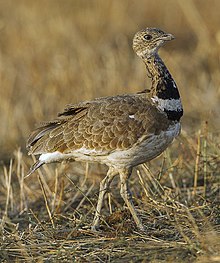Little bustard
| Little bustard | ||||||||||
|---|---|---|---|---|---|---|---|---|---|---|

Pair of Little Bustards ( Tetrax tetrax ) |
||||||||||
| Systematics | ||||||||||
|
||||||||||
| Scientific name | ||||||||||
| Tetrax tetrax | ||||||||||
| ( Linnaeus , 1758) |
The little bustard ( Tetrax tetrax , in the 19th century Otis tetrax , even Grieltrappe ) is the smallest, such as chickens large type from the family of bustards . The little bustard was also a breeding bird in Central Europe until the 19th century. It now occurs only in eastern Central Europe as a very rare random visitor .
features
The 40 to 45 cm long bustard reaches a weight of 500 to 900 g with a wingspan of 83 to 91 cm.
The neck of the rooster is deep black with two white stripes in a splendid dress. The head and throat are lead gray, the upper side of the body is sandy brown with dark markings and the lower side is white.
The female and the male in simple dress are colored sand-colored with black spots on the upper side. The abdomen and chest are colored white.
In flight the bird shows the medium-long, rounded wings with slightly curved hand wings and a lot of white on the upper sides of the wings and the arm wings. In contrast, the tips of the wings and ceilings are black.
Occurrence
The little bustard occurs in southern Europe in Spain, Portugal, southern France and Sardinia. The European population is continuously declining. Local populations on the Balkan Peninsula and probably also on mainland Italy have already died out. In northern France, the species is a summer bird. Outside Europe, it lives in North Africa and in the steppes between the Black Sea and Lake Balkhash . The negative population trend there has so far been less pronounced. The little bustard lives in grassy and cultivated landscapes, often in dry, stony places. It is - depending on the population - either a migratory or a line bird.
behavior
The Little Bustard picks up seeds, grains, shoots, roots and insects from the ground. Outside the breeding season, the bird lives in larger flocks.
Reproduction
The little bustard breeds once a year from April to June. During the courtship ritual, the male spreads his neck feathers, shows his wings and makes short leaps in the air over the vegetation. The courtship call is a loud grunting trrr that is repeated every ten seconds. The female lays three to five eggs in good cover in a shallow hollow in the ground.
Duration
The little bustard was formerly spread as a breeding bird in Germany, Poland, Austria, the Czech Republic, Slovakia and Hungary. At the beginning of the 20th century the species was exterminated in Central Europe due to intensive agriculture and irrigation measures. The closest breeding sites today are in France. It brooded in Alsace, among others, until the 1980s.
The total European population is estimated at 120,000 to 300,000 breeding pairs. That corresponds to about 75 to 94 percent of the world's population. About 90 percent of European breeding birds are found on the Iberian Peninsula. About another 10,000 to 20,000 breeding pairs live in the European part of Russia.
supporting documents
literature
- Hans-Günther Bauer, Einhard Bezzel , Wolfgang Fiedler (eds.): The compendium of birds in Central Europe: Everything about biology, endangerment and protection. Volume 1: Nonpasseriformes - non-sparrow birds. Aula-Verlag Wiebelsheim, Wiesbaden 2005, ISBN 3-89104-647-2 .
- Rob Hume : Birds in Europe. Dorling Kindersly Limited, London 2002, ISBN 3-8310-0430-7 .
- Anne Puchta, Klaus Richarz: Steinbach's great bird guide. Eugen Ulmer KG, Stuttgart 2006, ISBN 3-8001-4864-1 .
- Svensson, Grant, Mullarney, Zetterström: The new cosmos bird guide. Franckh-Kosmos Verlags-GmbH, Stuttgart 1999, ISBN 3-440-07720-9 .
Web links
- Tetrax tetrax in the endangered Red List species the IUCN 2008. Posted by: BirdLife International, 2008. Accessed on December 19 of 2008.
- Videos, photos and sound recordings for Tetrax tetrax in the Internet Bird Collection
- Little bustard feathers
Single receipts
- ^ German dictionary by Jacob and Wilhelm Grimm " Grieltrappe "
- ↑ Bauer et al., P. 382.
- ↑ Bauer et al., P. 382.



